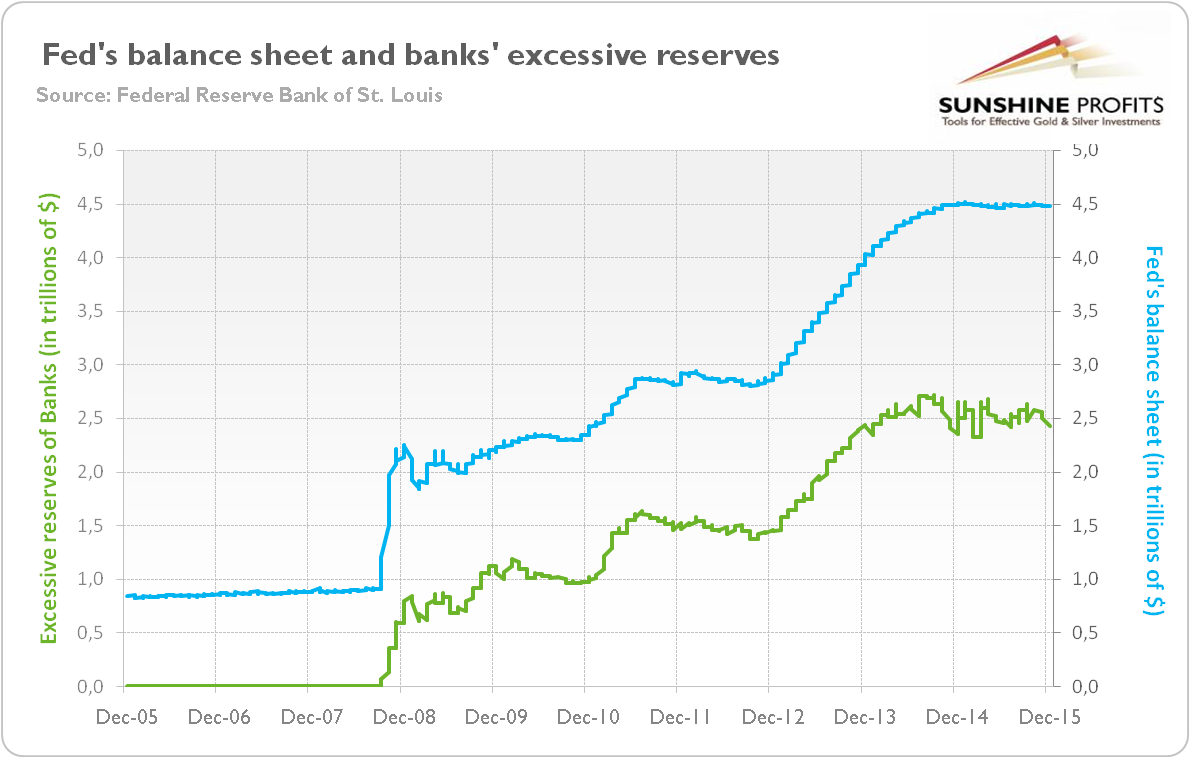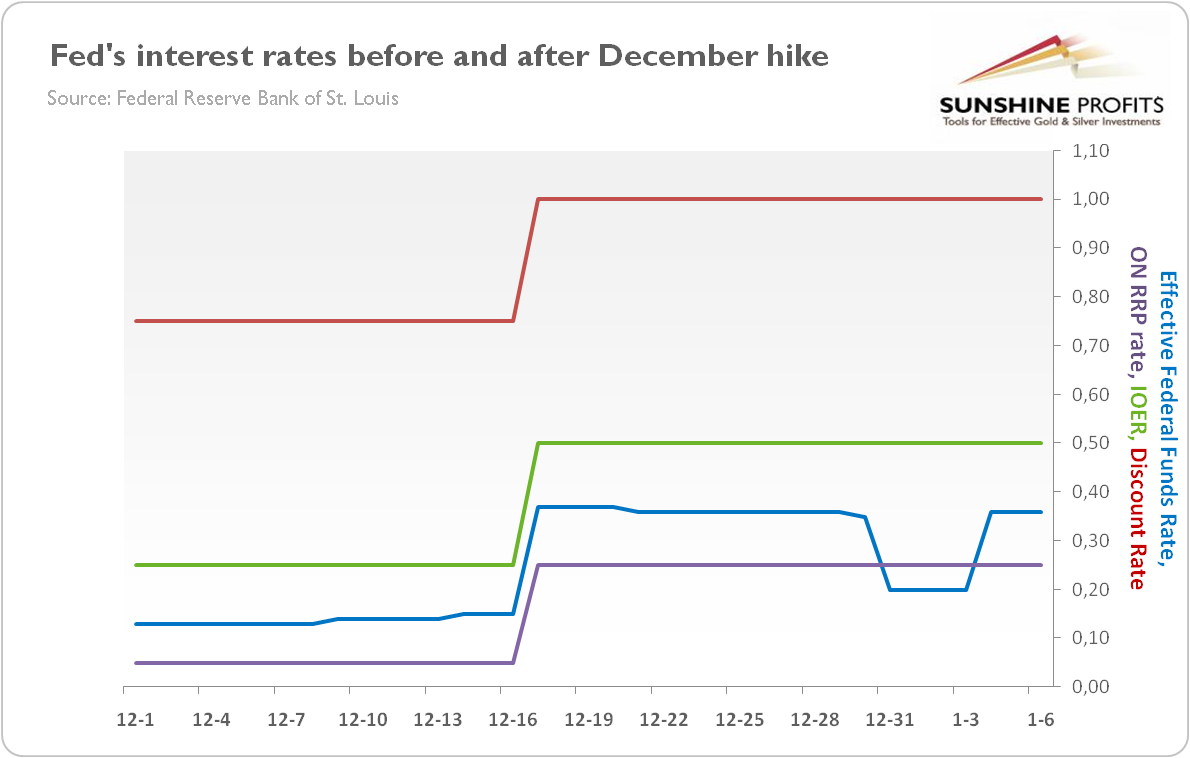Second, the Fed has never hiked before from almost zero. Thus, to normalize its monetary stance and provide itself with the necessary ammunition to fight the next downturn, the Fed should hike to at least 3.5 percent (usually, the U.S. central banks cut the federal funds rate by 350 basis points in each easing cycle). Given the slow and gradual tightening cycle, the Fed will be generally unprepared for another recession. The U.S. central bank will then be forced to implement another round of quantitative easing, or perhaps even to implement helicopter money and negative interest rates.
Third, the Fed has never raised its interest rates with the interbank lending market practically dormant, massive excess reserves at commercial banks (worth around $2.4 trillion) and enormously expanded balance sheets. The U.S. central bank’s balance sheet is now around $4.5 trillion, as opposed to the $800-900 billion range before the crisis (see the chart below).

In normal times, the U.S. central bank controlled the federal funds rate by changing the supply of reserves via open market operations. When the Fed wanted to raise rates, it would sell securities, which led to a reduction of reserves in the banking system. As the reserves become scarcer, the interest rate increased. However, because of the Fed’s quantitative easing programs, the banks are now awash with reserves, so they do not need to borrow funds from each other as they used to before the financial crisis. It means that to raise interest rates by open market operations, the Fed would need to unwind all of its earlier purchases (around $3.6 trillion since 2008).
Therefore, the U.S. central bank will be using two other tools during the normalization process: interest on excess reserves (IOER) and reverse repurchase operations (RRP). The IOER is interest paid on funds held at the Fed in excess of what is required, and it would be the primary tool for raising the federal funds rate. According to the U.S. central bank, the IOER puts a “floor” on the main Fed rate, as no bank would want to lend money to other banks at lower rates than it may safely park cash at the Fed.
However, there is a notable problem with the IOER. It does not create a perfect floor since it is only available to depositary institutions (among other problems), which do not have accounts with the Fed, so they would lend money for less. This is when the reverse repurchase operations enter the scene. In the RRP, the Fed sells securities to the non-banks (such as money market funds) and agrees to buy it back the next day at a specified price. In essence, the U.S. central bank takes an overnight collateral loan, which also puts a floor under the federal funds rate, as no investor would lend money to commercial banks at a rate lower than what the Fed is willing to pay in the RRP. As one can see, the main difference between these two interest rates is different eligible entities. Since the investors who can participate in the RRP are the same ones who might undercut the IOER, the changes in both rates should push up the federal funds rate. Indeed, the Fed’s strategy has worked so far.
Along with the federal funds rate, the U.S. central bank raised the IOER to 0.5 percent, while the overnight RPP rate rose to 0.25 percent (it also increased the discount rate to 1.00 percent. That is, the rate charged to depository institutions on loans they receive from the Fed’s lending facility, which creates the “ceiling” on the federal funds rate, since no banks should want to borrow money from other banks at a higher rate than from the U.S. central bank. Consequently, the effective federal funds rate was traded on average at 0.375 percent after the Fed’s hike (a level three times higher than 0.125 percent in 2015 before the hike!). The chart below shows the Fed’s interest rates before and after the December hike. As one can see, the effective rate is actually formed between the ON RRP rate and IOER, which were set during December meeting at, respectively, the lower and upper bounds of the federal funds target.

Therefore, it seems that the Fed, by using new tools, retained control over its main interest rates. However, there may be some unintended consequences of using them. First, paying banks for holding reserves at the Fed provides banks with easy money and discourages them from participating in the interbank market and from more intense restructuring (not to mention the ethical and political issues related to the fact that the U.S. central bank pays tens of billions of dollars to the banks not to use the trillions it paid them before). Second, the use of RPP would expand the Fed’s intermediation in short-term funding markets, which could crowd out private financing (the U.S. central bank is already the largest lender in the tri-party repo market), magnifying flight-to-quality flows and their repercussions during crises – as the investors will likely to seek the safety of the Fed (the ultimate ‘risk-free’ counterparty) instead of lending to private institutions – and promote ‘shadow banking’ (by transacting with non-banks) that are largely beyond the Fed’s regulatory scrutiny.
The bottom line is that the Fed raised the federal funds rate in December. After the end of quantitative easing, the hike was the next step toward the normalization of monetary policy. There is still a long way to return to normal monetary policy, as the Fed should raise interest rates significantly above zero and unwind its balance sheet. Therefore, the Fed stance will remain accommodative for a long time, as the U.S. central bank will not start selling its assets until the normalization of the federal funds rate is well under way. This is very good news for the gold market, since the quick normalization of the Fed’s balance sheet would boost the real interest rates, which are negatively correlated with the price of bullion. Another piece of positive news for the gold bulls is also that the tightening cycle would be slow and gradual, and based on the use of relatively new tools, such as IOER and RRP. As the Fed is entering unchartered waters, the use of these interest rates could alter financial markets in unpredictable ways and further impair the functioning of free markets and risk loss of the Fed’s credibility in case of losing the control over the federal funds rate in case of some negative shocks.
All essays, research and information found above represent analyses and opinions of Przemyslaw Radomski, CFA and Sunshine Profits' employees and associates only. As such, it may prove wrong and be a subject to change without notice. Opinions and analyses were based on data available to authors of respective essays at the time of writing. Although the information provided above is based on careful research and sources that are believed to be accurate, Przemyslaw Radomski, CFA and his associates do not guarantee the accuracy or thoroughness of the data or information reported. The opinions published above are neither an offer nor a recommendation to purchase or sell any securities. Mr. Radomski is not a Registered Securities Advisor. By reading Przemyslaw Radomski's, CFA reports you fully agree that he will not be held responsible or liable for any decisions you make regarding any information provided in these reports. Investing, trading and speculation in any financial markets may involve high risk of loss. Przemyslaw Radomski, CFA, Sunshine Profits' employees and affiliates as well as members of their families may have a short or long position in any securities, including those mentioned in any of the reports or essays, and may make additional purchases and/or sales of those securities without notice.
Recommended Content
Editors’ Picks
EUR/USD fluctuates near 1.0700 after US data

EUR/USD stays in a consolidation phase at around 1.0700 in the American session on Wednesday. The data from the US showed a strong increase in Durable Goods Orders, supporting the USD and making it difficult for the pair to gain traction.
USD/JPY refreshes 34-year high, attacks 155.00 as intervention risks loom

USD/JPY is renewing a multi-decade high, closing in on 155.00. Traders turn cautious on heightened risks of Japan's FX intervention. Broad US Dollar rebound aids the upside in the major. US Durable Goods data are next on tap.
Gold stays in consolidation above $2,300

Gold finds it difficult to stage a rebound midweek following Monday's sharp decline but manages to hold above $2,300. The benchmark 10-year US Treasury bond yield stays in the green above 4.6% after US data, not allowing the pair to turn north.
Worldcoin looks set for comeback despite Nvidia’s 22% crash Premium

Worldcoin price is in a better position than last week's and shows signs of a potential comeback. This development occurs amid the sharp decline in the valuation of the popular GPU manufacturer Nvidia.
Three fundamentals for the week: US GDP, BoJ and the Fed's favorite inflation gauge stand out Premium

While it is hard to predict when geopolitical news erupts, the level of tension is lower – allowing for key data to have its say. This week's US figures are set to shape the Federal Reserve's decision next week – and the Bank of Japan may struggle to halt the Yen's deterioration.